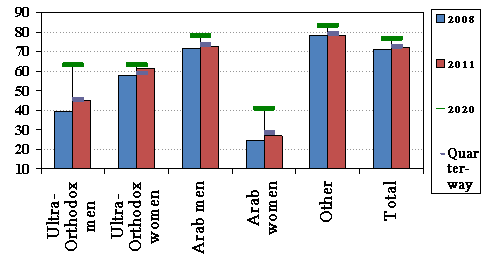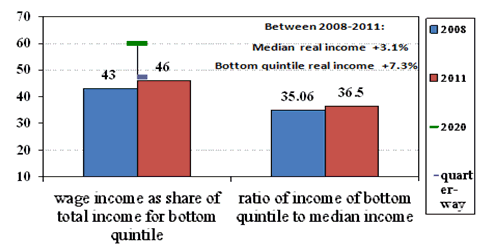| 16.04.2012 |
| |
Remarks by Bank of Israel Deputy Governor Dr. Karnit Flug at a meeting of the team which is monitoring the socioeconomic agenda:
What progress has been made in achieving the goals of the government's socioeconomic agenda |
|---|
|
| |
| To view this press release as a WORD file - Click here |
|
| |
|
| |
| In 2007, a Socioeconomic Agenda for Israel in 2008–10 was published. The agenda report, led by Professor Manuel Trajtenberg and the National Economic Council, presented a wide-ranging socioeconomic agenda which centered on encouraging employment while reducing poverty indices. In 2010, the Committee for Examining Employment Policy headed by the previous Deputy Governor, Prof. Zvi Eckstein, proposed employment targets which included specific targets for various population groups and ages. These targets were adopted by the government (Decision 1994, dated July 15, 2010). |
| Deputy Governor Dr. Karnit Flug presented to the agenda team, headed by Ministry of Finance Acting Director General Mr. Doron Cohen, updated employment figures for 2011, and their proximity to the targets: |
| The main targets set: |
 |
Employment targets (for age group 25–64) for 2020: |
|
| |
|
| |
 |
A poverty target under which the rate of increase in income of the bottom quintile of households in 2010–20 will be 10 percent greater than the increase in the median income in that period. |
 |
An increase in the share of wage income out of total average income of the bottom quintile from 47 percent in 2010 to 60 percent in 2020. |
| Employment targets: |
|---|
|
| |
|
| |
| The figures indicate that except for Arab women, it appears that developments in employment to date are on a path consistent with meeting the targets which the government set for itself in this area. |
|---|
| Dr. Flug used Central Bureau of Statistics data before recent changes in the Labor Force Surveys, and noted that there is a need to revise the employment targets so that they will be based on the new measurements. |
| Other targets: |
|
| |
|
| |
| The share of wage income out of total income for the bottom quintile increased, and reflects increased integration of the population with lower income into the employment market. With that, the rate of progress was slower than required in order to reach the target set for 2020. As far as the target for reducing poverty, the income of the bottom quintile increased in real terms by 7.3 percent, compared with an increase of 3.1 percent in the median income. That is, the goal was met, and the gap between the bottom quintile and the median income narrowed. |
|
| |


